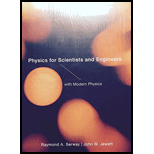
(a)
The average power of the elevator motor.
(a)
Answer to Problem 38P
The average power of the elevator motor is
Explanation of Solution
Write the expression for average power
Here,
Consider the elevator as an isolated system.
Write the expression for work done by the motor on the elevator
Simplify the above expression.
Here,
Since the direction of force and displacement is same, hence the angle
Substitute
Simplify the above equation
Substitute
Write the expression for total force when the system is moving with an acceleration.
Here,
Write the expression for total force acting on the system
Here,
Substitute
Consider the elevator as an isolated system and the motion of elevator is by force acting by motor, the elevator starts from rest when a force is applied by motor against the gravitational force of the elevator.
The gravitaional force is negative because it is in opposite to the direction of acceleration.
Write the expression for force due to gravity.
Here,
Substitute
Simplify the above equation.
Consider the motion of elevator from rest to the speed of its cruising speed.
Write the equation of motion for velocity in terms of acceleration and time
Here,
Since the initial speed is zero.
Substitute
Simplify the above equation to find the expression for
Write the equation of motion for distance travelled in terms of acceleration, time and initial speed.
Here,
Since the initial speed is zero.
Substitute
Substitute
Simplify the above equation.
Conclusion:
Substitute
Substitute
Substitute
Substitute
Thus, the average power of the elevator motor is
(b)
The comparison between average power and the power when elevator moves with cruising speed.
(b)
Answer to Problem 38P
The instantaneous power required is
Explanation of Solution
Write the expression for instaneous power when the elevator is moving at a constant cruising speed
Simplify the above expression
Here,
Since the force and velocity are in same direction, hence the angle between
Substitute
Simplify the above equation.
Here,
Since the elevator moves at constant speed when it reaches cruising speed, hence the acceleration will be zero.
Write the expression for comparison in both powers
Here,
Since the elevator is moving at constant speed hence the acceleration is zero.
Substitute
Simplify the above equation
Conclusion:
Substitute
Substitiute
Substitute
Thus, the instantaneous power required is
Want to see more full solutions like this?
Chapter 8 Solutions
Physics For Scientists And Engineers With Modern Physics, 9th Edition, The Ohio State University
- need help part a and barrow_forwardComplete the table below for spherical mirrors indicate if it is convex or concave. Draw the ray diagrams S1 10 30 S1' -20 20 f 15 -5 Marrow_forwardA particle with a charge of − 5.20 nC is moving in a uniform magnetic field of (B→=−( 1.22 T )k^. The magnetic force on the particle is measured to be(F→=−( 3.50×10−7 N )i^+( 7.60×10−7 N )j^. Calculate the scalar product v→F→. Work the problem out symbolically first, then plug in numbers after you've simplified the symbolic expression.arrow_forward
- Need help wity equilibrium qestionarrow_forwardneed answer asap please thanks youarrow_forwardA man slides two boxes up a slope. The two boxes A and B have a mass of 75 kg and 50 kg, respectively. (a) Draw the free body diagram (FBD) of the two crates. (b) Determine the tension in the cable that the man must exert to cause imminent movement from rest of the two boxes. Static friction coefficient USA = 0.25 HSB = 0.35 Kinetic friction coefficient HkA = 0.20 HkB = 0.25 M₁ = 75 kg MB = 50 kg P 35° Figure 3 B 200arrow_forward
- A golf ball is struck with a velocity of 20 m/s at point A as shown below (Figure 4). (a) Determine the distance "d" and the time of flight from A to B; (b) Determine the magnitude and the direction of the speed at which the ball strikes the ground at B. 10° V₁ = 20m/s 35º Figure 4 d Barrow_forwardThe rectangular loop of wire shown in the figure (Figure 1) has a mass of 0.18 g per centimeter of length and is pivoted about side ab on a frictionless axis. The current in the wire is 8.5 A in the direction shown. Find the magnitude of the magnetic field parallel to the y-axis that will cause the loop to swing up until its plane makes an angle of 30.0 ∘ with the yz-plane. Find the direction of the magnetic field parallel to the y-axis that will cause the loop to swing up until its plane makes an angle of 30.0 ∘ with the yz-plane.arrow_forwardA particle with a charge of − 5.20 nC is moving in a uniform magnetic field of (B→=−( 1.22 T )k^. The magnetic force on the particle is measured to be (F→=−( 3.50×10−7 N )i^+( 7.60×10−7 N )j^. Calculate the y and z component of the velocity of the particle.arrow_forward
 Physics for Scientists and Engineers, Technology ...PhysicsISBN:9781305116399Author:Raymond A. Serway, John W. JewettPublisher:Cengage Learning
Physics for Scientists and Engineers, Technology ...PhysicsISBN:9781305116399Author:Raymond A. Serway, John W. JewettPublisher:Cengage Learning Principles of Physics: A Calculus-Based TextPhysicsISBN:9781133104261Author:Raymond A. Serway, John W. JewettPublisher:Cengage Learning
Principles of Physics: A Calculus-Based TextPhysicsISBN:9781133104261Author:Raymond A. Serway, John W. JewettPublisher:Cengage Learning College PhysicsPhysicsISBN:9781305952300Author:Raymond A. Serway, Chris VuillePublisher:Cengage Learning
College PhysicsPhysicsISBN:9781305952300Author:Raymond A. Serway, Chris VuillePublisher:Cengage Learning Glencoe Physics: Principles and Problems, Student...PhysicsISBN:9780078807213Author:Paul W. ZitzewitzPublisher:Glencoe/McGraw-Hill
Glencoe Physics: Principles and Problems, Student...PhysicsISBN:9780078807213Author:Paul W. ZitzewitzPublisher:Glencoe/McGraw-Hill College PhysicsPhysicsISBN:9781285737027Author:Raymond A. Serway, Chris VuillePublisher:Cengage Learning
College PhysicsPhysicsISBN:9781285737027Author:Raymond A. Serway, Chris VuillePublisher:Cengage Learning University Physics Volume 1PhysicsISBN:9781938168277Author:William Moebs, Samuel J. Ling, Jeff SannyPublisher:OpenStax - Rice University
University Physics Volume 1PhysicsISBN:9781938168277Author:William Moebs, Samuel J. Ling, Jeff SannyPublisher:OpenStax - Rice University





